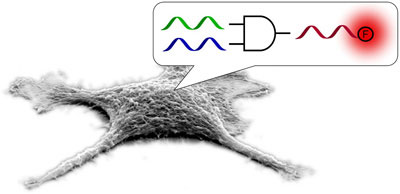| Jul 10, 2013 |
Researchers perform DNA computation in living cells
|
|
(Nanowerk News) Chemists from North Carolina State University have performed a DNA-based logic-gate operation within a human cell. The research may pave the way to more complicated computations in live cells, as well as new methods of disease detection and treatment ("DNA Computation in Mammalian Cells: microRNA Logic Operations").
|
|
Logic gates are the means by which computers “compute,” as sets of them are combined in different ways to enable computers to ultimately perform tasks like addition or subtraction. In DNA computing, these gates are created by combining different strands of DNA, rather than a series of transistors. However, thus far DNA computation events have typically taken place in a test tube, rather than in living cells.
|
 |
| Representation of a Boolean AND gate within a living cell. MicroRNA inputs lead to output in the form of a fluorescent molecule.
|
|
NC State chemist Alex Deiters and graduate student James Hemphill wanted to see if a DNA-based logic gate could detect the presence of specific microRNAs in human cells. The researchers utilized a DNA-based logic gate known as an “AND” gate that was engineered to respond to the presence of two specific microRNAs – known as miRNA-21 and miRNA-122.
|
|
Just as computer operations utilize different inputs to create a particular output, the researchers’ DNA-based Boolean logic gate was activated only when both miRNA-21 and miRNA-122 “inputs” were present in cells. If they were present, the gate generated an “output” by releasing a fluorescent molecule.
|
|
Deiters believes that use of these logic gates could lead to more accurate tests and treatments for human disease, especially cancer.
|
|
“The fluorescent molecule we used in this logic-gate design could be useful as a marker that identifies a cancer cell,” he says. “Or, instead of directing the gate to release a fluorescent molecule in the presence of particular microRNAs, we could attach therapeutic agents that are released to treat the disease itself.”
|

